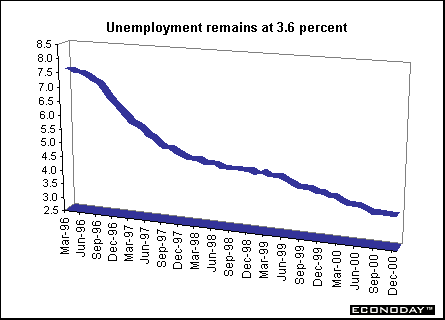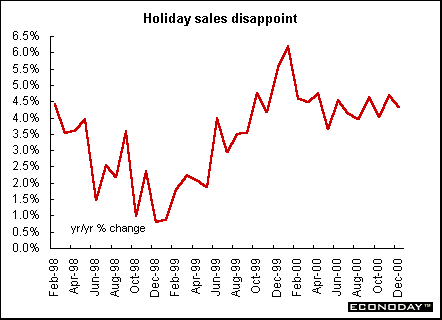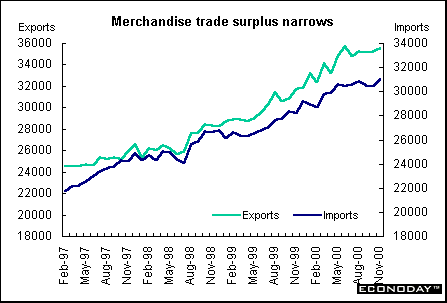
Indicator scoreboard
EMU - Third quarter seasonally adjusted real gross domestic product was unrevised at 0.7 percent and rose 3.4 percent when compared with last year. However, second quarter growth was revised upward to 0.9 percent and 3.8 percent when compared with last year. Growth in consumer spending, which accounts for more than half of GDP, slowed to 0.3 percent in the third quarter from 0.7 percent in the previous three months. Inventory growth was revised down to 0.6 percent from 0.9 percent, while domestic demand slowed to 0.6 percent from the 0.9 percent first estimated. Export growth was unrevised at 3 percent, though import growth was revised down to 3 percent from 3.7 percent.

November seasonally adjusted industrial production reversed course and rose 0.6 percent after a slip of 0.1 percent in October. When compared with last year, industrial production rose 4.4 percent. This was the fourth increase in five months. The advance was led by a 1 percent jump in big ticket consumer goods such as stereos and refrigerators. Intermediate goods such as glass and chemicals rose 0.7 percent on the month while heavy machinery and factory equipment climbed 0.8 percent.

Germany - November retail sales declined 1.3 percent after falling a revised 0.4 percent in October. This was the third straight monthly decline. Retail sales rose 0.5 percent from a year ago, with sales of food, beverages and tobacco rising 2.7 percent, and medical and cosmetic goods increasing 5.7 percent. Fuel sales plunged 14.7 percent and clothing declined 2.2 percent. A separate report from the Bundesbank, which uses a different method to adjust the figures for seasonal influences, showed overall retail sales declining 0.1 percent in November from October and dropping 0.9 percent on the year. Excluding sales of cars and at gas stations, German retail sales rose 0.4 percent in the month and gained 0.5 percent in the year.

December wholesale prices declined 0.3 percent and rose 5.1 percent when compared with last year. Energy and manufactured products price declines were partly offset by higher prices for seasonal foods. The monthly decline was largely due to falling energy product prices, down 5.2 percent after a 3.8 percent drop in November. Excluding oil products, wholesale prices rose 0.5 percent with the annual inflation rate unchanged at 3.5 percent. Excluding seasonal food prices, wholesale prices fell 0.7 percent on the month and rose 4.7 percent on the year.
November manufacturing orders data were revised up strongly to a gain of 0.9 percent on the month, a sharp reversal from an originally reported drop of 0.9 percent. Orders were revised up for both west (up 0.8 percent from down 0.8 percent) and east (up 1.1 percent from down 1.7 percent) Germany. The sharp upward revision was due to revisions for the automobile industry, foreign orders for investment goods and office equipment orders received by east German firms. In addition, the quality of the original data was poor due to an over reliance on estimates ahead of the Christmas holiday rush, as order data were not yet complete at the time. Both domestic and foreign orders were revised up sharply -- domestic orders to up 1.4 percent from an originally reported up 0.3 percent and foreign orders to up 0.2 percent from down 2.5 percent.
France - November seasonally adjusted merchandise trade balance was E12 million. Exports rose 1.9 percent led by large capital projects, computer equipment, pharmaceuticals, perfumes, electronics and metals. While exports to other EU countries stagnated, exports to other regions accelerated, for a gain of 10 percent in two months. Imports turned down, dipping 0.9 percent due to a "sharp contraction" for consumer goods and data equipment. The energy deficit narrowed to E2.093 billion from E2.411 billion
November seasonally and workday adjusted manufacturing output rose 0.4 percent and 3.3 percent when compared with last year. Monthly gains were led by the auto industry, where production rose a further 1.7 percent and 5.6 percent on the year. Consumer goods output rose 1.1 percent. Capital goods output also firmed, posting a 0.4 percent gain after no change in October.
Italy - November seasonally and workday adjusted industrial production rose 1.0 percent and 2.4 percent when compared with last year. Seasonally adjusted consumer goods' output gained a hefty 1.3 percent on the month and an unadjusted 1.4 percent on the year. Output of investment goods increased an adjusted 0.4 percent and 3.0 percent on the year, while intermediate goods rose 1.0 percent on the month, up 2.5 percent on the year.
October industrial orders were soared 15.2 percent when compared with last year. The strongest increases were in the textiles and clothing sector (up 22.8 percent), in the transportation sector (up 22.4 percent) and in the leather and footwear sector (up 21.4 percent). ISTAT recently introduced seasonally adjusted monthly orders data, which is still not closely followed by most analysts, showed October's orders rose 1.5 percent from September. Domestic orders climbed 1.0 percent on the month, while orders from abroad were up 2.2 percent.
Britain - December seasonally adjusted producer input prices plummeted 3.5 percent and were up 5.7 percent when compared with a year earlier. The reason behind the sharp monthly drop was the cost of crude oil, which fell 18.2 percent on the month. This was the biggest monthly decline since February 1991. Crude oil prices are still up 16.2 percent on a year earlier. Seasonally adjusted core output prices were down 0.1 percent on the month and up 0.6 percent on the year.
December retail price index excluding mortgage interest payments (RPIX) rose 0.1 percent and 2 percent when compared with last year. This is below the Bank of England's inflation target of 2.5 percent. The RPIX has been below the Bank's inflation target since April 1999. The retail price Index (RPI) rose 0.1 percent and 2.9 percent when compared with last year. The retail price index excluding both mortgage interest payments and indirect taxes (RPIY) also rose 0.1 percent and was up 1.7 percent on the year.

Average earnings growth for the three months to November remained steady at 4.2 percent even though the figure for the single month rose 4.2 percent because of higher wages in the manufacturing and public sectors. Earnings rose in the manufacturing sector to 4.5 percent from 4.3 percent in October while pay growth in services remained steady at 4.2 percent. The Bank of England's target rate for the three month average rate is 4.5 percent.

December unemployment rate remained at 3.6 percent for the fifth straight month and the lowest since October 1975. Unemployment on the International Labor Organization measure in the three months to November rose 11,000 on the previous period but was down 162,000 on the year. The ILO unemployment rate fell to 5.3 percent, down from 5.5 percent in the previous period.

December seasonally adjusted retail sales volumes crept up 0.1 percent but rose 4.4 percent when compared with last year. Despite the sluggish end to the year, sales growth in the fourth quarter was still up 1.3 percent on the previous quarter and up 4.4 percent on a year earlier. Sales of household goods were the main source of strength in the month and were up 0.9 percent.

Asia
Japan - November current account surplus unexpectedly widened as a smaller services account deficit and a larger income account offset a drop in the trade surplus. The surplus in the current account, the broadest measure of trade in goods and services, rose 22.1 percent from a year earlier lifted by an increase in the income account surplus, which tracks the flow of dividends and interest payments in and out of Japan. The trade surplus, which accounts for most of the current account surplus, fell 3.9 percent from a year earlier as growth in imports continued to outpace exports, which had long been the engine of Japan's economic growth. Overall imports grew 12.8 percent from a year earlier, largely because of higher oil prices. The figure outpaced the growth in exports of 9.2 percent.
November industrial output was left at an unrevised decline of 0.8 percent from the previous month. Shipments were revised down to a decline of 0.4 percent. Production capacity, before adjustment for seasonal factors, remained unchanged in November but was down 1.0 percent from a year earlier in the 22nd straight month of on-year drops.
Australia - Fourth quarter manufactured goods prices rose 2.5 percent - the largest increase in more than a decade. When compared with last year, prices increased 8.4 percent - making it the seventh consecutive quarterly rise. Export prices jumped 7.3 percent in the last quarter of 2000 - the biggest increase in five years. The Australian dollar, which fell 15 percent against its U.S. counterpart last year, increased the cost of imported components for manufactured goods. At the same time, it boosted export earnings. High oil costs also increased manufacturing prices.
Americas
Canada - December consumer price index edged up by 0.1 percent. Rising consumer prices for fresh vegetables, fresh fruit, fuel oil and fresh or frozen meat (excluding poultry) led the advance. Lower prices for gasoline, traveler accommodation, and air transportation dampened the overall monthly index increase. When compared with last year, the CPI rose 3.2 percent. Higher energy prices accounted for more than one-third of the rise in the CPI between December 1999 and December 2000. Excluding energy, the CPI rose 2.2 percent. On a seasonally adjusted basis the CPI rose 0.3 percent in December and 2.78 percent when compared with last year. The CPI excluding food and energy also rose 0.3 percent in December but only 1.9 percent when compared with last year.

November merchandise trade surplus slipped to C$44.5 billion, down from C$4.9 billion in October as imports increased at almost three times the pace of exports. Imports were up 2.2 percent as a record level of industrial goods and materials were purchased. Crude petroleum imports were also strong. However, a 4.2 percent decline in imports of automobile products dampened the overall increase. Exports rose 0.8 percent with strong sales of electricity to California and high exports of natural gas almost offsetting a decline in exports of machinery and equipment, particularly telecommunications equipment. Exports of energy products rose 11.0 percent thanks to the chaos in the California electricity market, which propelled exports to a record C$500 million, more than double October's level. Natural gas exports rose 7.9 percent to C$1.7 billion and crude petroleum exports rose 2.8 percent to C$1.7 billion. The trade surplus with the United States rose to C$8.539 billion in November from a revised C$8.148 billion in October. Canada posted a deficit of C$69 million with Japan in November, a decline from the revised C$150 million deficit in the prior month. All other countries also showed a deficit.

 |


Introduction • Global Stock Market Indexes • Recap of Global Markets • Currencies • Indicator Scoreboard

The Bottom Line • Looking Ahead
© Econoday, 2000-2001. All Rights Reserved.
|